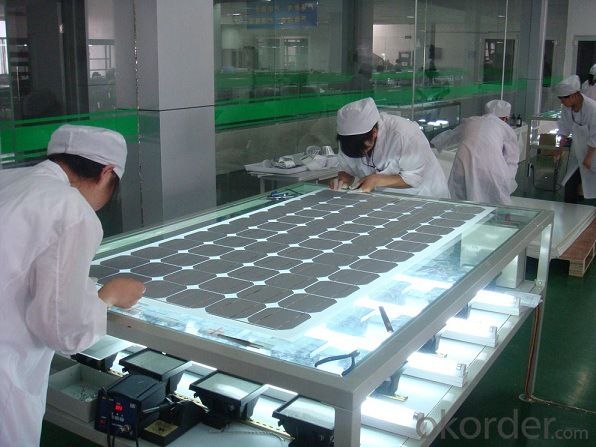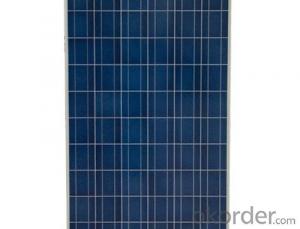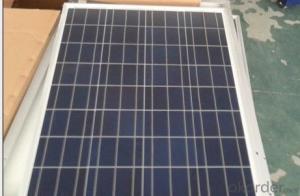Crystalline Solar Panels Made in China/India
- Loading Port:
- Shanghai
- Payment Terms:
- TT OR LC
- Min Order Qty:
- 78000 watt
- Supply Capability:
- 10000000 watt/month
OKorder Service Pledge
OKorder Financial Service
You Might Also Like
Poly-Crystalline solar panel, Poly 156 cell, 60pcs.Power range 230W-260W.
Solar panel refers either to a photovoltaic (PV) module, a solar hot water panel, or to a set of solar photovoltaic modules electrically connected and mounted on a supporting structure. A PV module is a packaged, connected assembly of solar cells. Solar panels can be used as a component of a larger photovoltaic system to generate and supply electricity in commercial and residential applications. Each module is rated by its DC output power under standard test conditions, and typically ranges from 100 to 320 watts. The efficiency of a module determines the area of a module given the same rated output – an 8% efficient 230 watt module will have twice the area of a 16% efficient 230 watt module. There are a few solar panels available that are exceeding 19% efficiency. A single solar module can produce only a limited amount of power; most installations contain multiple modules. A photovoltaic system typically includes a panel or an array of solar modules, an inverter, and sometimes a battery and/or solar tracker and interconnection wiring.

Quality and Safety
1. Rigorous quality control meets the highest international standards.
2. High-transmissivity low-iron tempered glass, strong aluminium frame.
3. Using UV-resistant silicon.
4. IS09001/14001/CE/TUV/UL
Warranties
1. 10 years limited product warranty
2. 15 years at 90% of the minimal rated power output
3. 25 years at 80% of the minimal rated power output
Technical date :
ITEM NO.: | Poly 156*156 cell ,60pcs . Power range from 230Wp-260Wp | ||||||
Maximum Power(W) | 230 | 235 | 240 | 245 | 250 | 255 | 260 |
Optimum Power Voltage(Vmp) | 29.4 | 29.5 | 29.7 | 30.1 | 30.3 | 30.5 | 30.7 |
Optimum Operatige Current(Imp) | 7.83 | 7.97 | 8.08 | 8.14 | 8.25 | 8.37 | 8.48 |
Open Circuit Voltage(Voc) | 36.7 | 36.8 | 36.9 | 37.1 | 37.3 | 37.5 | 37.7 |
Short Circuit Current(Isc) | 8.52 | 8.59 | 8.62 | 8.65 | 8.69 | 8.73 | 8.78 |
Solar Cell: | 156*156 Poly | ||||||
Number of Cell(pcs) | 6*10 | ||||||
Brand Name of Solar Cells | JA Cell, Bluesun Cell | ||||||
Size of Module(mm) | 1650*992*40/45/50 | ||||||
Cable & Connector Type | Pass the TUV Certificate | ||||||
Frame(Material Corners,etc.) | Aluminium-alloy | ||||||
Back sheet | TPT | ||||||
Weight Per Piece(KG) | 19.5KG | ||||||
FF (%) | 70-76% | ||||||
Junction Box Type | Pass the TUV Certificate | ||||||
Tolerance Wattage(e.g.+/-5%) | ±3%, or 0-3% | ||||||
Front Glass Thickness(mm) | 3.2 | ||||||
Temperature Coefficients of Isc(%) | +0.04 | ||||||
Temperature Coefficients of Voc(%) | -0.38 | ||||||
Temperature Coefficients of Pm(%) | -0.47 | ||||||
Temperature Coefficients of Im(%) | +0.04 | ||||||
Temperature Coefficients of Vm(%) | -0.38 | ||||||
Temperature Range | -40°C to +85°C | ||||||
Surface Maximum Load Capacity | 5400Pa | ||||||
Allowable Hail Load | 23m/s ,7.53g | ||||||
Bypass Diode Rating(A) | 12 | ||||||
Warranty | 90% of 10 years, 80% of 25 years. | ||||||
Standard Test Conditions | AM1.5 1000W/ 25 +/-2°C | ||||||
Packing | carton or pallet | ||||||
1*20' | 14 Pallets / 316pcs | ||||||
1*40'STD | 25 Pallets / 700pcs | ||||||

FAQ
I..Will you focus on the safety of the goods during transportation?
Yes, Safety of the cargo is the primary element that we would consider on transportation.
II..How would guarantee the quality will meet the requirements of your clients?
Before shipment, we will have inspection for each batch of goods.
III..What certificates do you have?
IEC,UL,TUV,CSA,etc.
IV..Can you do OEM according to clients’ requirements?
Yes, we have our own brand while we can provide OEM service.
- Q:For example, how many large solar panels would you need to operate a greenhouse with lighting for simulate sun during cloudy weather, a scheduled sprinkle system and other such things?I'm looking for a very in depth answer.
- We think that powerful solar panels are good . As per their capacity they of-course needed many many solar panels, tks.
- Q:hi,i have 4 solar panels. I can get 9V 400mA when i wired them parallel. The question is: how can i make a regulator circuit to store power into batteries.
- wire them in series parallel to get 8 volts at 200 mA, and that should charge a 2 volt battery. You may want to put in a series diode to prevent the battery from discharging into the panel when the sun is out. At 200 mA, depending on the battery size, you may not need much control, as that low a current will not overcharge a large battery, like a small auto battery. In fact it will take a very long time to charge it. edit: But do i need to add a regulator? If by that you mean a voltage regulator, no, as a solar panel has a high output resistance, and that will limit the current into the battery. If you mean a charge controller, if the battery is small, you may need a charge contoller to avoid overcharging the battery. But that is not a voltage regulator. .
- Q:What about sources for straight forward solar powered products? Excluding toys, garden frogs and outdoorpath lights I have found few useful items for the home. What I have found are solar panels for under $00 each, inverters, rechargeable indoor lights and a few camping/RV products that are interesting. It seems to me that these could help me start to wean the family off the power company. I can't afford to go cold turkey and cover my roof with solar panels and I don't think the HOA would allow me to even if I could. Is anyone using solar on a small scale?
- Homemade okorder
- Q:I want to be more self sufficient and get solar panels for electricity in a small house any tips will help. i need to know how many watts is enough and ect.
- With a small house it may not be necessary to put solar panels in it. The wattage that is needed will not be much of a difference when using electricity.
- Q:Are there any health risks associated with solar panels?
- No, there are no significant health risks associated with solar panels. Solar panels do not emit any harmful substances or pollutants that could pose a threat to human health. However, it is important to handle and install them properly to avoid any potential accidents or injuries.
- Q:Do solar panels require a battery for storage?
- No, solar panels do not require a battery for storage. Solar panels generate electricity directly from the sunlight and can be connected to the electrical grid to supply power during the day. However, using a battery with solar panels allows for energy storage, ensuring a continuous power supply even when the sun is not shining or during power outages.
- Q:can solar panels have glass between the panels and the sun?
- PV panels do not have to be in direct sunlight. If they are behind glass they need to be well ventilated to remove excess heat. If PV cells connected in series are not uniformly illuminated the series will produce an amount of power that is based on the light on the least illuminated cell. Thus moving a panel back from a window will mean that for large parts of the day it will produce almost no power as parts of the panel are shaded. This applies only when the cells are connected in series. In parallel they suffer no special degradation of production, but just the sum of illuminated cells. This makes a difference when you decide to use a higher voltage panel... high voltage panels are more susceptible to partial shading. But connecting low voltage panels in series gives that same degradation. Stay away from placing a panel back away from the window, or close to the edges of the window, under roof overhangs, trees and surrounding building shade, where possible.
- Q:I need to have more information about what are solar panels. will you help me?
- How photograph voltaic Cells artwork by using Scott Aldous interior this text a million. introduction to How photograph voltaic Cells artwork 2. Photovoltaic Cells: changing Photons to Electrons 3. How Silicon Makes a photograph voltaic cellular 4. Anatomy of a photograph voltaic cellular 5. power Loss in a photograph voltaic cellular 6. photograph voltaic-powering a house 7. fixing photograph voltaic-capacity themes 8. photograph voltaic-capacity experts and Cons 9. lots greater advice 0. See all actual technology articles you have in all probability considered calculators that have photograph voltaic cells -- calculators that never want batteries, and in specific circumstances do no longer even have an off button. as long as you have sufficient mild, they seem to artwork consistently. you're transforming into considered greater suitable photograph voltaic panels -- on emergency street indicators or call packing packing containers, on buoys, even in parking lots to capacity lights fixtures. whether those greater suitable panels are not so straight forward as photograph voltaic powered calculators, they are accessible, and not that stressful to discover in case you comprehend the place to look. There are photograph voltaic cellular arrays on satellites, the place they are used to capacity the electrical powered systems. you have in all probability additionally been listening to with regards to the photograph voltaic revolution for the final 20 years -- the theory at some point we are able to all use unfastened electricity from the solar. it somewhat is a seductive promise: On a dazzling, sunny day, the solar shines approximately a million,000 watts of power according to sq. meter of the planet's floor, and if we could collect all of that power we could unquestionably capacity our homes and workplaces for unfastened.
- Q:Can solar panels be installed on a mobile home?
- Yes, solar panels can be installed on a mobile home. In fact, mobile homes are well-suited for solar installations due to their compact size and portability. Installing solar panels can provide mobile homeowners with an eco-friendly and cost-effective alternative to traditional energy sources.
- Q:Can solar panels be installed on a government building or facility?
- Yes, solar panels can be installed on a government building or facility. In fact, many government entities have already started incorporating solar energy as a sustainable and cost-effective solution to meet their energy needs. Solar panels not only help reduce carbon emissions but also provide long-term savings on electricity bills.
1. Manufacturer Overview |
|
|---|---|
| Location | |
| Year Established | |
| Annual Output Value | |
| Main Markets | |
| Company Certifications | |
2. Manufacturer Certificates |
|
|---|---|
| a) Certification Name | |
| Range | |
| Reference | |
| Validity Period | |
3. Manufacturer Capability |
|
|---|---|
| a)Trade Capacity | |
| Nearest Port | |
| Export Percentage | |
| No.of Employees in Trade Department | |
| Language Spoken: | |
| b)Factory Information | |
| Factory Size: | |
| No. of Production Lines | |
| Contract Manufacturing | |
| Product Price Range | |
Send your message to us
Crystalline Solar Panels Made in China/India
- Loading Port:
- Shanghai
- Payment Terms:
- TT OR LC
- Min Order Qty:
- 78000 watt
- Supply Capability:
- 10000000 watt/month
OKorder Service Pledge
OKorder Financial Service
Similar products
New products
Hot products
Hot Searches
Related keywords






























